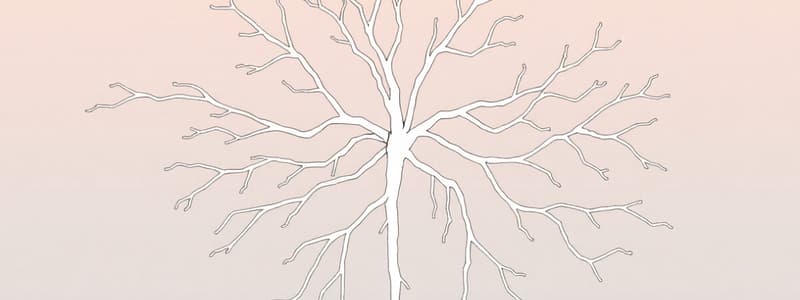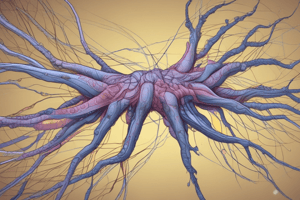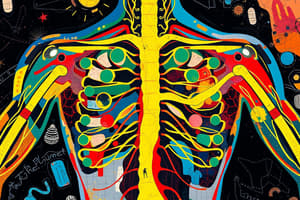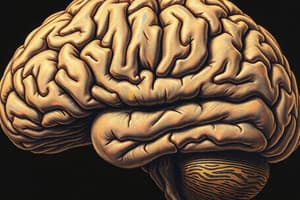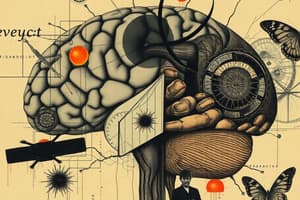Podcast
Questions and Answers
What is the primary function of collateral ganglia in the sympathetic nervous system?
What is the primary function of collateral ganglia in the sympathetic nervous system?
- To innervate viscera within the abdominopelvic cavity (correct)
- To innervate the respiratory system
- To control voluntary muscle movements in the limbs
- To synapse with preganglionic neurons and directly stimulate the adrenal medulla
Which statement accurately describes the location of intramural ganglia?
Which statement accurately describes the location of intramural ganglia?
- Located in the thoracic cavity
- Located near the spinal cord
- Situated outside the target organ
- Found within the walls of the target organ (correct)
The adrenal medulla functions to release which neurotransmitters into the bloodstream?
The adrenal medulla functions to release which neurotransmitters into the bloodstream?
- Norepinephrine and cortisol
- Epinephrine and norepinephrine (correct)
- Acetylcholine and dopamine
- Serotonin and epinephrine
What role does the vagus nerve (CN X) fulfill in the parasympathetic nervous system?
What role does the vagus nerve (CN X) fulfill in the parasympathetic nervous system?
Which of the following accurately describes the interaction of preganglionic fibers within the sympathetic chain?
Which of the following accurately describes the interaction of preganglionic fibers within the sympathetic chain?
What is the primary function of the sympathetic division of the autonomic nervous system?
What is the primary function of the sympathetic division of the autonomic nervous system?
Which of the following accurately describes the effects of the parasympathetic division?
Which of the following accurately describes the effects of the parasympathetic division?
Where are the sensory receptors for the sympathetic division primarily located?
Where are the sensory receptors for the sympathetic division primarily located?
What does the enteric nervous system primarily regulate?
What does the enteric nervous system primarily regulate?
What critical function is inhibited by the sympathetic division during a stress response?
What critical function is inhibited by the sympathetic division during a stress response?
Which structures serve as effectors for both the sympathetic and parasympathetic divisions?
Which structures serve as effectors for both the sympathetic and parasympathetic divisions?
How many pairs of sympathetic trunk ganglia are located along the vertebral column?
How many pairs of sympathetic trunk ganglia are located along the vertebral column?
What effect does the parasympathetic division have on pupil size?
What effect does the parasympathetic division have on pupil size?
Which action is primarily driven by the sympathetic nervous system?
Which action is primarily driven by the sympathetic nervous system?
What role does the enteric nervous system have in relation to the sympathetic and parasympathetic divisions?
What role does the enteric nervous system have in relation to the sympathetic and parasympathetic divisions?
What is a primary function of astrocytes in the CNS?
What is a primary function of astrocytes in the CNS?
Which statement is true about oligodendrocytes?
Which statement is true about oligodendrocytes?
What role do ependymal cells play in the central nervous system?
What role do ependymal cells play in the central nervous system?
What do satellite cells do in the peripheral nervous system?
What do satellite cells do in the peripheral nervous system?
Which function is specifically associated with somatic efferent neurons?
Which function is specifically associated with somatic efferent neurons?
What distinguishes visceral afferent neurons from somatic afferent neurons?
What distinguishes visceral afferent neurons from somatic afferent neurons?
What is the primary mechanism of a chemical synapse?
What is the primary mechanism of a chemical synapse?
Which of the following correctly describes the process of decussation in the somatic sensory pathways?
Which of the following correctly describes the process of decussation in the somatic sensory pathways?
What type of information is primarily transmitted by the dorsal column (medial lemniscus) pathway?
What type of information is primarily transmitted by the dorsal column (medial lemniscus) pathway?
In the context of the anterolateral pathway, where does the 1st-order neuron synapse?
In the context of the anterolateral pathway, where does the 1st-order neuron synapse?
What is the function of the thalamus in the sensory pathway?
What is the function of the thalamus in the sensory pathway?
Which statement about the 2nd-order neuron in the somatic sensory pathways is true?
Which statement about the 2nd-order neuron in the somatic sensory pathways is true?
Which type of sensory information is NOT transmitted by the anterolateral pathway?
Which type of sensory information is NOT transmitted by the anterolateral pathway?
Which type of sensory neuron begins at the sensory receptor in both pathways discussed?
Which type of sensory neuron begins at the sensory receptor in both pathways discussed?
Which of the following accurately describes the role of effector organs?
Which of the following accurately describes the role of effector organs?
What distinguishes the anterior tract from the lateral tract in the anterolateral pathway?
What distinguishes the anterior tract from the lateral tract in the anterolateral pathway?
Which muscles are primarily innervated by the Lateral Corticospinal Tract?
Which muscles are primarily innervated by the Lateral Corticospinal Tract?
Where do the upper motor neurons of the Ventral Corticospinal Tract originate?
Where do the upper motor neurons of the Ventral Corticospinal Tract originate?
What is the main purpose of a reflex arc in the nervous system?
What is the main purpose of a reflex arc in the nervous system?
At which spinal cord area does the decussation of the Lateral Corticospinal Tract occur?
At which spinal cord area does the decussation of the Lateral Corticospinal Tract occur?
What is the outcome when a spinal cord injury occurs?
What is the outcome when a spinal cord injury occurs?
What role do interneurons play during the reflex arc process?
What role do interneurons play during the reflex arc process?
Which type of muscles do upper motor neurons innervate within the Ventral Corticospinal Tract?
Which type of muscles do upper motor neurons innervate within the Ventral Corticospinal Tract?
Where does the sensory neuron enter the spinal cord during a reflex action?
Where does the sensory neuron enter the spinal cord during a reflex action?
Which functions are regulated by the Autonomic Nervous System?
Which functions are regulated by the Autonomic Nervous System?
What happens to the motor neuron after an injury to the spinal cord?
What happens to the motor neuron after an injury to the spinal cord?
What is the primary role of the motor nervous system in the body?
What is the primary role of the motor nervous system in the body?
Which of the following best describes the function of sensory neurons?
Which of the following best describes the function of sensory neurons?
Which term describes the group of neuron cell bodies located in the peripheral nervous system?
Which term describes the group of neuron cell bodies located in the peripheral nervous system?
What is the main action of microglial cells in the central nervous system?
What is the main action of microglial cells in the central nervous system?
Which fiber type is responsible for carrying sensory information from the body to the central nervous system?
Which fiber type is responsible for carrying sensory information from the body to the central nervous system?
In which structural division of the nervous system are meninges found?
In which structural division of the nervous system are meninges found?
What distinguishes somatic efferent neurons from visceral efferent neurons?
What distinguishes somatic efferent neurons from visceral efferent neurons?
What is the primary function of postganglionic fibers originating from the collateral ganglia?
What is the primary function of postganglionic fibers originating from the collateral ganglia?
Which of the following accurately describes the location of terminal ganglia?
Which of the following accurately describes the location of terminal ganglia?
What distinguishes intramural ganglia from terminal ganglia in terms of location?
What distinguishes intramural ganglia from terminal ganglia in terms of location?
Which cranial nerve is primarily responsible for increasing secretion from glands in the mouth?
Which cranial nerve is primarily responsible for increasing secretion from glands in the mouth?
What is a significant effect of neurotransmitter release from the adrenal medulla during a stress response?
What is a significant effect of neurotransmitter release from the adrenal medulla during a stress response?
What structural feature differentiates motor pathways from sensory pathways?
What structural feature differentiates motor pathways from sensory pathways?
Which type of matter is primarily responsible for processing and integrating information in the spinal cord?
Which type of matter is primarily responsible for processing and integrating information in the spinal cord?
What is the role of the lower motor neuron in the somatic motor pathways?
What is the role of the lower motor neuron in the somatic motor pathways?
Which of the following structures is not involved in the sensory pathway?
Which of the following structures is not involved in the sensory pathway?
What type of muscles does the Lateral Corticospinal Tract primarily innervate?
What type of muscles does the Lateral Corticospinal Tract primarily innervate?
Which characteristic correctly describes white matter in the spinal cord?
Which characteristic correctly describes white matter in the spinal cord?
Where does the Upper Motor Neuron of the Ventral Corticospinal Tract decussate?
Where does the Upper Motor Neuron of the Ventral Corticospinal Tract decussate?
Which type of information is transmitted specifically by the dorsal root ganglion?
Which type of information is transmitted specifically by the dorsal root ganglion?
What adjustment mechanism refines muscle contractions in the pyramidal and corticobulbar tracts?
What adjustment mechanism refines muscle contractions in the pyramidal and corticobulbar tracts?
In a reflex arc, which structure is responsible for conducting information away from the spinal cord?
In a reflex arc, which structure is responsible for conducting information away from the spinal cord?
Which of the following two types of neurons are involved in somatic motor pathways?
Which of the following two types of neurons are involved in somatic motor pathways?
What is the role of the spinal cord when a reflex arc is activated?
What is the role of the spinal cord when a reflex arc is activated?
Which statement is true regarding spinal cord injuries?
Which statement is true regarding spinal cord injuries?
What feature distinguishes gray matter in the spinal cord?
What feature distinguishes gray matter in the spinal cord?
Which of the following accurately describes the autonomic nervous system's primary function?
Which of the following accurately describes the autonomic nervous system's primary function?
What is the path of the sensory signal from the skin during its transmission?
What is the path of the sensory signal from the skin during its transmission?
Which part of a reflex arc is activated first when touching a hot object?
Which part of a reflex arc is activated first when touching a hot object?
Where do the neurons in the lateral corticospinal tract primarily originate?
Where do the neurons in the lateral corticospinal tract primarily originate?
During a reflex action, what happens to the motor neuron after exiting the spinal cord?
During a reflex action, what happens to the motor neuron after exiting the spinal cord?
What is the primary characteristic of the reflex arc?
What is the primary characteristic of the reflex arc?
What is one of the key roles of astrocytes in the central nervous system?
What is one of the key roles of astrocytes in the central nervous system?
Which type of glial cell is responsible for forming the myelin sheath around axons in the peripheral nervous system?
Which type of glial cell is responsible for forming the myelin sheath around axons in the peripheral nervous system?
What distinguishes oligodendrocytes from Schwann cells?
What distinguishes oligodendrocytes from Schwann cells?
What is a primary function of ependymal cells in the central nervous system?
What is a primary function of ependymal cells in the central nervous system?
Which function is specifically associated with visceral afferent neurons?
Which function is specifically associated with visceral afferent neurons?
How do oligodendrocyte progenitor cells (OPCs) contribute to the central nervous system?
How do oligodendrocyte progenitor cells (OPCs) contribute to the central nervous system?
What is the mechanism by which a chemical synapse operates?
What is the mechanism by which a chemical synapse operates?
In the peripheral nervous system, what is the role of satellite cells?
In the peripheral nervous system, what is the role of satellite cells?
Which of the following tissues is specifically innervated by somatic efferent neurons?
Which of the following tissues is specifically innervated by somatic efferent neurons?
Flashcards
Astrocytes: What are their roles?
Astrocytes: What are their roles?
The most numerous type of glial cell in the CNS, they are responsible for a variety of functions such as maintaining the blood-brain barrier, regulating neurotransmitter levels, and providing support and energy to neurons.
Ependymal cells: What do they do?
Ependymal cells: What do they do?
Line the brain's ventricles and are responsible for the production and circulation of cerebrospinal fluid. They contribute to the formation of the choroid plexus.
Oligodendrocytes: What is their function?
Oligodendrocytes: What is their function?
Provide insulation and support to axons by forming the myelin sheath. One oligodendrocyte can myelinate multiple axons.
Oligodendrocyte progenitor cells (OPCs): What type of cell is this?
Oligodendrocyte progenitor cells (OPCs): What type of cell is this?
Signup and view all the flashcards
Schwann cells (neurolemmocytes): What is their function?
Schwann cells (neurolemmocytes): What is their function?
Signup and view all the flashcards
Satellite cells: What is their function?
Satellite cells: What is their function?
Signup and view all the flashcards
Chemical Synapse: How does this work?
Chemical Synapse: How does this work?
Signup and view all the flashcards
What are effector organs, specifically skeletal muscles?
What are effector organs, specifically skeletal muscles?
Signup and view all the flashcards
What do somatic sensory pathways do?
What do somatic sensory pathways do?
Signup and view all the flashcards
How many neurons are involved in somatic sensory pathways?
How many neurons are involved in somatic sensory pathways?
Signup and view all the flashcards
What kind of information does the dorsal column pathway transmit?
What kind of information does the dorsal column pathway transmit?
Signup and view all the flashcards
Describe the pathway of the dorsal column.
Describe the pathway of the dorsal column.
Signup and view all the flashcards
What does the anterolateral pathway carry?
What does the anterolateral pathway carry?
Signup and view all the flashcards
Describe the pathway of the anterolateral system.
Describe the pathway of the anterolateral system.
Signup and view all the flashcards
What is the role of the thalamus in sensory processing?
What is the role of the thalamus in sensory processing?
Signup and view all the flashcards
How does the thalamus help with sensation?
How does the thalamus help with sensation?
Signup and view all the flashcards
Sympathetic Division
Sympathetic Division
Signup and view all the flashcards
Parasympathetic Division
Parasympathetic Division
Signup and view all the flashcards
Enteric Nervous System
Enteric Nervous System
Signup and view all the flashcards
What is the main function of the sympathetic division?
What is the main function of the sympathetic division?
Signup and view all the flashcards
What are some key functions of the sympathetic division?
What are some key functions of the sympathetic division?
Signup and view all the flashcards
What is the main function of the parasympathetic division?
What is the main function of the parasympathetic division?
Signup and view all the flashcards
What are some key functions of the parasympathetic division?
What are some key functions of the parasympathetic division?
Signup and view all the flashcards
What is the main function of the enteric nervous system?
What is the main function of the enteric nervous system?
Signup and view all the flashcards
What are some key functions of the enteric nervous system?
What are some key functions of the enteric nervous system?
Signup and view all the flashcards
Where are sympathetic trunk ganglia located?
Where are sympathetic trunk ganglia located?
Signup and view all the flashcards
Lateral Corticospinal Tract
Lateral Corticospinal Tract
Signup and view all the flashcards
Ventral Corticospinal Tract
Ventral Corticospinal Tract
Signup and view all the flashcards
Lateral Corticospinal Tract: UMN Pathway
Lateral Corticospinal Tract: UMN Pathway
Signup and view all the flashcards
Lateral Corticospinal Tract: LMN Pathway
Lateral Corticospinal Tract: LMN Pathway
Signup and view all the flashcards
Ventral Corticospinal Tract: UMN Pathway
Ventral Corticospinal Tract: UMN Pathway
Signup and view all the flashcards
Ventral Corticospinal Tract: LMN Pathway
Ventral Corticospinal Tract: LMN Pathway
Signup and view all the flashcards
Spinal Cord Injury
Spinal Cord Injury
Signup and view all the flashcards
Reflex Arc
Reflex Arc
Signup and view all the flashcards
Spinal Cord in Reflex Arc
Spinal Cord in Reflex Arc
Signup and view all the flashcards
Overview of Autonomic Nervous System
Overview of Autonomic Nervous System
Signup and view all the flashcards
Sympathetic Chain Ganglia
Sympathetic Chain Ganglia
Signup and view all the flashcards
Collateral Ganglia (Prevertebral Ganglia)
Collateral Ganglia (Prevertebral Ganglia)
Signup and view all the flashcards
Adrenal Medulla
Adrenal Medulla
Signup and view all the flashcards
Terminal Ganglia
Terminal Ganglia
Signup and view all the flashcards
Intramural Ganglia
Intramural Ganglia
Signup and view all the flashcards
Central Nervous System (CNS)
Central Nervous System (CNS)
Signup and view all the flashcards
Peripheral Nervous System (PNS)
Peripheral Nervous System (PNS)
Signup and view all the flashcards
Motor (Efferent) Nervous System
Motor (Efferent) Nervous System
Signup and view all the flashcards
Sensory (Afferent) Nervous System
Sensory (Afferent) Nervous System
Signup and view all the flashcards
Ganglia
Ganglia
Signup and view all the flashcards
Nerve
Nerve
Signup and view all the flashcards
Synapse
Synapse
Signup and view all the flashcards
Ventral (Anterior) Corticospinal Tract
Ventral (Anterior) Corticospinal Tract
Signup and view all the flashcards
What is a reflex arc?
What is a reflex arc?
Signup and view all the flashcards
Spinal Cord's role in a reflex arc
Spinal Cord's role in a reflex arc
Signup and view all the flashcards
What is the function of motor pathways?
What is the function of motor pathways?
Signup and view all the flashcards
What is the function of sensory pathways?
What is the function of sensory pathways?
Signup and view all the flashcards
What is the function of gray matter in the spinal cord?
What is the function of gray matter in the spinal cord?
Signup and view all the flashcards
What is the function of white matter in the spinal cord?
What is the function of white matter in the spinal cord?
Signup and view all the flashcards
What are the pyramidal tracts?
What are the pyramidal tracts?
Signup and view all the flashcards
How is the dorsal root ganglion involved in sensory pathways?
How is the dorsal root ganglion involved in sensory pathways?
Signup and view all the flashcards
What role does the ventral horn play in motor pathways?
What role does the ventral horn play in motor pathways?
Signup and view all the flashcards
What is the role of the basal nuclei in motor pathways?
What is the role of the basal nuclei in motor pathways?
Signup and view all the flashcards
What is the role of the cerebellum in motor pathways?
What is the role of the cerebellum in motor pathways?
Signup and view all the flashcards
How are nerve plexuses involved in motor pathways?
How are nerve plexuses involved in motor pathways?
Signup and view all the flashcards
What are the roles of astrocytes?
What are the roles of astrocytes?
Signup and view all the flashcards
What is the function of ependymal cells?
What is the function of ependymal cells?
Signup and view all the flashcards
What is the function of Oligodendrocytes?
What is the function of Oligodendrocytes?
Signup and view all the flashcards
What are the functions of Schwann cells?
What are the functions of Schwann cells?
Signup and view all the flashcards
What are the roles of Satellite cells?
What are the roles of Satellite cells?
Signup and view all the flashcards
What are the functions of Somatic efferent neurons?
What are the functions of Somatic efferent neurons?
Signup and view all the flashcards
What are the functions of Somatic afferent neurons?
What are the functions of Somatic afferent neurons?
Signup and view all the flashcards
What are the functions of Visceral efferent neurons?
What are the functions of Visceral efferent neurons?
Signup and view all the flashcards
What are the functions of Visceral afferent neurons?
What are the functions of Visceral afferent neurons?
Signup and view all the flashcards
Collateral Ganglia
Collateral Ganglia
Signup and view all the flashcards
Study Notes
Learning Outcomes - Nervous System Organization
- Define ganglia, nerve, synapse, afferent fiber (sensory neuron), efferent fiber (motor neuron), and interneuron.
- Differentiate between the functional and structural divisions of the nervous system.
- Compare the tissues and structures innervated by somatic efferent, somatic afferent, visceral efferent, and visceral afferent neurons.
- Recall the functions of neuroglia and differentiate between CNS and PNS neuroglia.
- Differentiate between electrical and chemical synapses.
Structural Divisions of the Nervous System
- Central Nervous System (CNS): Consists of the brain and spinal cord, integrating and processing nervous information; protected by meninges.
- Peripheral Nervous System (PNS): All neural tissue outside the CNS; carries information to and from the CNS to the body, enabling responses.
Functional Division of the Nervous System
- Motor (Efferent) Nervous System: Carries information away from the CNS to muscle tissue in the PNS. Initiates the responses to the collected information.
- Sensory (Afferent) Nervous System: Collects sensory information (stimuli) from the body's internal and external environments, transmitting the information to the CNS for processing.
Important Definitions
- Ganglia: Groups of neuron cell bodies in the PNS
- Nerve: Bundles of axons in the PNS
- Synapse: Junction between neurons (or between a neuron and other cells like muscle) allowing information transmission
- Sensory (afferent) neurons: carry signals from the body to the CNS
- Motor (efferent) neurons: carry signals from the CNS to muscles or glands
- Interneurons: Connect neurons within the CNS to process and relay information
- Afferent Fiber: Carries sensory information toward the CNS
- Efferent Fiber: Carries motor commands from the CNS
- Neuroglia: Supporting cells of the nervous system, non-transmitting electrical signals
Neuroglial Cells in the CNS
- Microglial cells: Immune cells of the CNS, removing damaged neurons, infectious agents, and preventing inflammation.
- Astrocytes: Most common glial cells, contributing to the blood-brain barrier, maintaining the physical structure of the brain, regulating neurotransmitter levels, and regulating the extracellular environment, including ion concentrations
- Ependymal cells: Line the brain's ventricles, help produce and circulate cerebrospinal fluid
- Oligodendrocytes: Provide support and insulation to axons by forming the myelin sheath, which enhances signal transmission
Neuroglial Cells in the PNS
- Schwann cells (neurolemmocytes): Form the myelin sheath, insulating axons, and enhancing signal transmission
Satellite cells
- Flat cells surrounding neuron cell bodies in ganglia, separating cell bodies from interstitial fluid and regulating exchanges between neurons and environment
Types of Neurons and Innervated Tissues
- Somatic Efferent Neurons: CNS to skeletal muscles (voluntary control)
- Somatic Afferent Neurons: Sensory receptors to CNS (skin, muscles, joints, etc)
- Visceral Efferent Neurons: CNS to smooth muscle, cardiac muscle, and glands (involuntary control)
- Visceral Afferent Neurons: Internal organs to CNS
Chemical Synapse
- Neurotransmitters are released from the presynaptic neuron to the postsynaptic cell.
- The signal is transmitted in one direction.
- Examples include neuromuscular junctions (muscle), synapses between neurons, and synapses in the central nervous system.
Electrical Synapse
- Directly connected by gap junctions.
- Electrical signals travel directly in both directions.
- Examples include smooth muscle, cardiac muscle, and some neurons
Spinal Cord; Sensory & Motor Tracts
- Spinal Cord: Describe the somatic nervous system, relate components to previously discussed topics, recognize afferent and efferent pathways, distinguish between gray and white matter, compare sensory and motor tracts
Pain Reflex Arc
- Recognize the pain reflex arc as an example of structural and functional organization of the nervous system.
Autonomic Nervous System (ANS)
- Describe the ANS's 3 divisions and functions
- Compare and contrast ANS and somatic nervous systems
- Identify the role of the hypothalamus in ANS function
- Compare and contrast sympathetic & parasympathetic divisions based on types of sensory/motor neuron, locations of neurons, axon lengths, and neurotransmitters.
Other
- List the 3 locations of ganglia for the sympathetic division. (Paravertebral or sympathetic trunk ganglia, prevertebral or collateral ganglia, adrenal medulla)
- List the different nerve plexuses in the body, and what they do. (Brachial, Lumbar, Sacral plexuses and the nerves they contain and the muscles they innervate).
Studying That Suits You
Use AI to generate personalized quizzes and flashcards to suit your learning preferences.
